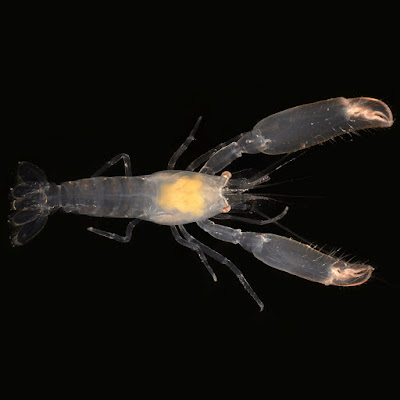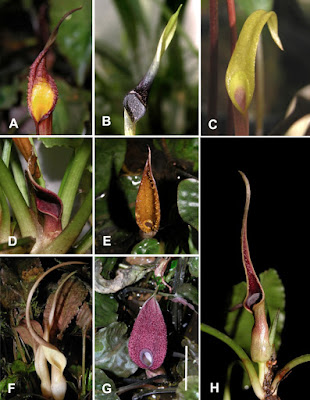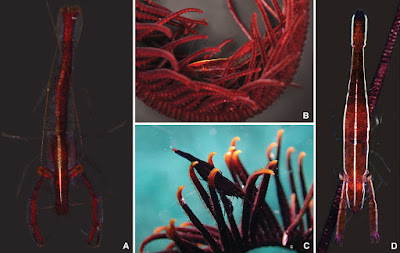[Most Recent Entries] [Calendar View]
Thursday, June 13th, 2019
| Time | Event | ||||
| 8:32a | [Crustacea • 2019] Periclimenaeus gorgonidarum (Balss, 1913) • On the Systematic Status of Isopericlimenaeus Marin, 2012 (Decapoda: Palaemonidae)
Abstract The palaemonid genus Isopericlimenaeus is currently comprised of only the type species, Isopericlimenaeus gorgonidarum, with the diagnostic character of the genus being the presence of a molar and fossa structure on both second chelipeds. Periclimenaeus uropodialis is a closely related species, which has either been considered a synonym of I. gorgonidarum or placed as a valid species in the related genus, Periclimenaeus. During fieldwork in the Philippines, Taiwan and Korea, several species of Periclimenaeus and other sponge associated shrimps belonging to the family Palaemonidae were collected, including I. gorgonidarum and P. uropodialis. Based on a morphological and molecular comparison, it is demonstrated that both taxa are conspecific and that Isopericlimenaeus is a junior synonym of Periclimenaeus. Keywords: Palaemonidae, Isopericlimenaeus gorgonidarum, Periclimenaeus uropodialis, phylogeny
Jin-Ho Park, Sammy De Grave and Won Kim. 2019. On the Systematic Status of Isopericlimenaeus Marin, 2012 and its Type Species, Periclimenaeus gorgonidarum (Balss, 1913) (Crustacea: Decapoda: Palaemonidae). Zootaxa. 4614(2); 353–367. DOI: 10.11646/zootaxa.4614.2.5 | ||||
| 9:52a | [Botany • 2019] Natural Hybridization – Recombination – An ever-ongoing Process ABSTRACT Exemplified by studies of the SE Asian genus Cryptocoryne (Araceae) we provide evidence that: 1) interspecific hybridization is an everongoing process, and introgression and gene exchange takes place whenever physically possible throughout the region; 2) artificial hybridization experiments confirm that wide crosses are possible in a large number of cases; 3) rivers and streams provide numerous, diverse habitats for Cryptocoryne diaspores to settle in; 4) the changes in habitats caused by recurrent glaciations resulting in numerous splitting and merging of populations facilitates hybridization and segregation of subsequent generations; 5) hybridization is a major driving element in speciation; 6) populations are the units and stepping stones in evolution – not the species. KEYWORDS: Araceae, Chromosome numbers, Cryptocoryne, hybridization, evolution Niels Jacobsen and Marian Ørgaard. 2019. Natural Hybridization – Recombination – An ever-ongoing Process. Thai Forest Bulletin (Botany). 47(1); 19-28. DOI: 10.20531/tfb.2019.47.1.05 | ||||
| 9:58a | [Crustacea • 2019] Cristimenes brucei • A New Species of the Genus Cristimenes Ďuriš & Horká, 2017 (Decapoda, Caridea, Palaemonidae)
Abstract A new species of crinoid-associated shrimp, Cristimenes brucei sp. nov., is described based on specimens from Korea, although the species also occurs in Hong Kong and is likely more widespread. The new species is morphologically very similar to C. commensalis, but can be distinguished by the reduced supraorbital tooth on the carapace. Cristimenes brucei sp. nov. is clearly recovered as a monophyletic species through COI barcode and molecular phylogenetic analyses based on four genetic markers (COI, 16S, H3, 18S). Keywords: Cristimenes brucei sp. nov., crinoid associate, Indo-West Pacific, Hong Kong, Korea, phylogeny Infraorder Caridea Dana, 1852 Family Palaemonidae Rafinesque, 1815 Genus Cristimenes Ďuriš & Horká, 2017 Cristimenes brucei sp. nov. Periclimenes commensalis l: Bruce 1982a: 236–238, fig. 2. Diagnosis: Rostrum well developed, with dorsal and ventral teeth. Carapace smooth, without epigastric tooth; lateral carinae feebly developed; supraorbital tooth reduced, blunt; inferior orbital angle pointed; antennal and hepatic teeth well developed. Fourth thoracic sternite without median process. Abdomen with rounded pleura. Telson with two pairs of small dorsal spiniform setae, and with three pairs of posterior spiniform setae. Eyes with hemispherical cornea. Basal antennular segment with two acute distolateral teeth. Antennal basicerite with sharp distoventral tooth; scaphocerite with large distolateral tooth, not reaching distal end of lamella. Epistome rounded. Mandible without palp; molar process robust; incisor process with four or five terminal teeth. Maxillula with bilobed palp. Maxilla with blunt palp, basal endite well developed, bilobed. First maxilliped with simple palp; basal and coxal endites fused; exopod with developed caridean lobe; epipod bilobed. Second maxilliped with subquadrate epipod, without podobranch. Third maxilliped with slender exopod; arthrobranch rudimentary. First pereiopods slender, fingers subspatulate with entire cutting edges. Second pereiopods equal in shape and subequal in size; palm articulated subproximally; cutting edges of fingers feebly dentate proximally, serrated distally. Dactyli of ambulatory pereiopods biunguiculate; corpus with two or three acute dorsodistal spinules, with acute preterminal accessory tooth. Uropodal exopod with distolateral tooth and movable acute spine. .... Etymology: The new species is named in honour of Dr AJ (Sandy) Bruce, in recognition of his considerable contribution to the systematics of Palaemonidae. Ecology: The specimens were collected from the crinoids Anneissia japonica, A. solaster and Catoptometra rubroflava at a depth of 15 – 27 m. Bruce (1982a) reported that the Hong Kong specimens were collected from Tropiometra afra (Hartlaub, 1890). Distribution: Presently only known from the type locality, Jeju Special Self-Governing Province, Korea as well as Hong Kong (Bruce 1982a). Jin-Ho Park, Sammy De Grave and Won Kim. 2019. A New Species of the Genus Cristimenes Ďuriš & Horká, 2017 (Decapoda, Caridea, Palaemonidae). ZooKeys. 852: 53-71. DOI: 10.3897/zookeys.852.34959 |
| << Previous Day |
2019/06/13 [Calendar] |
Next Day >> |








